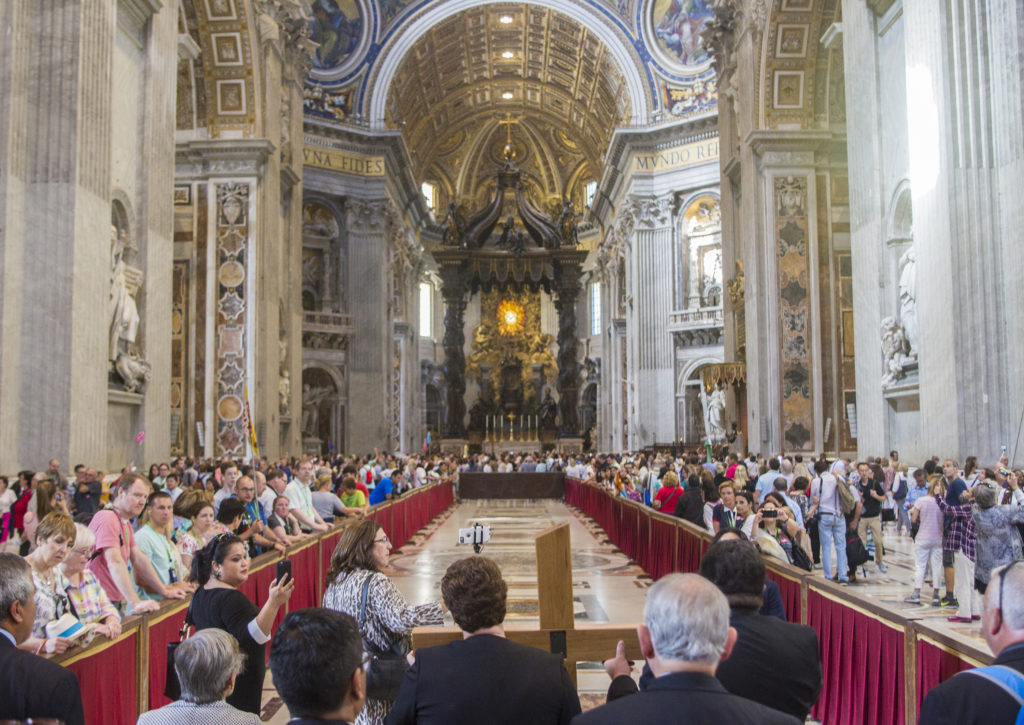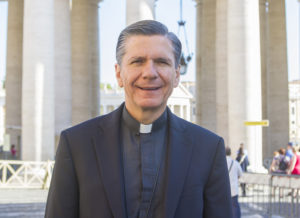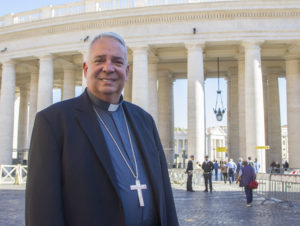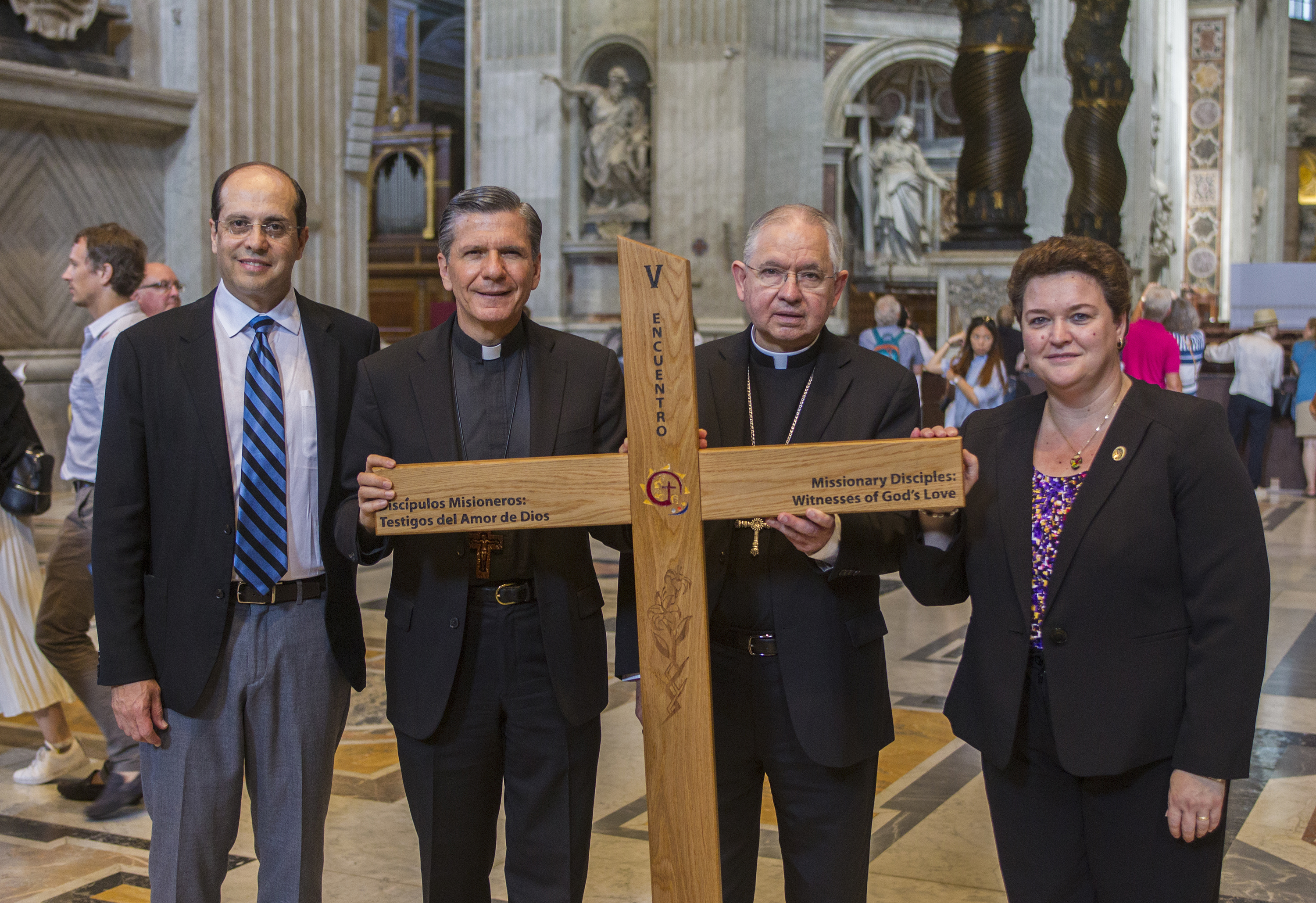
VATICAN CITY (CNS) — Carrying a tall wooden cross over the threshold of the Holy Door in St. Peter’s Basilica, a U.S. delegation brought the concerns of the country’s Hispanic Catholics to the heart of the church.
In a political climate marked by angry rhetoric, fear and division, U.S. bishops and others who minister to the Hispanic and Latino community are focused on “communion, unity, and service,” said Archbishop Gustavo Garcia-Siller of Dallas.
The archbishop, chairman of the U.S. Bishops’ Committee on Cultural Diversity in the Church, and other leaders traveled to the Vatican in late September to secure Pope Francis’ blessing on the V Encuentro process and on the Encuentro cross they carried to the tomb of St. Peter.
Taking part in a five-day pilgrimage to pray for the initiative, which begins in early 2017, the delegation also included: Archbishop Jose H. Gomez of Los Angeles; Auxiliary Bishop Nelson J. Perez of Rockville Centre, New York, chairman of the U.S. Bishops’ Subcommittee on Hispanic Affairs; and Auxiliary Bishop Arturo Cepeda of Detroit.
Receiving the pope’s blessing, Archbishop Garcia-Siller said, “gives us the strength to not allow ourselves to be overcome by the transitory elements of today’s culture, society and politics. We want to live something that is more transcendent.”
V Encuentro is “a four-year process of ecclesial reflection and action” geared toward finding new ways to engage and strengthen Hispanic and Latino Catholics and address their pastoral needs, according to the initiative’s website.

Archbishop Garcia-Siller told Catholic News Service Sept. 26 that the V Encuentro is an opportunity for Hispanic Catholics to “be firm in their faith,” which “goes beyond what politics offers today.”
Hispanic Catholics, he added, shouldn’t be alienated from the current political climate, but rather “be inside what is going on in today’s politics. But we have to do it presenting the Christian values we have received.”
Promoting the values of faith inherent in Latin American culture also can help strengthen both Spanish- and English-speaking Catholics to “go beyond the upcoming election,” the archbishop said.
Archbishop Garcia-Siller, like many Catholic leaders in the United States, believes that the gap between immigrant families and citizens is not the only challenge facing younger and older generations of Hispanics.
Younger generations who assimilate to U.S. culture are steadily forgetting the Spanish language that binds them not only to their own family history, but also to the Catholic faith.
The growing language barrier between older generations who speak only Spanish and younger generations who prefer to speak English is one of the many challenges V Encuentro will address in the next four years.
Alejandro Aguilera-Titus, director of the V Encuentro, told CNS that Encuentro’s four-year process “offers an opportunity for generating leadership within Hispanic and Latin American Catholics so that they may provide ministries for the church in the United States.”
Hispanic ministry – Diocese of Phoenix
Congreso Binacional Hispano de Respeto a la Vida y Evangelizacion
However, leadership cannot flourish without creating “broader spaces” that allow the growing Hispanic population to “fully participate in the life and the mission of the church,” he said.
The goal of the V Encuentro, Aguilera-Titus continued, is to answer Pope Francis’ call to reach out to the marginalized by fostering “an intense process of mission to Hispanics in the peripheries,” as well as inviting the whole church, especially non-Spanish speaking Catholics, to join in the outreach.
Some 5,000 U.S. parishes will participate in the Encuentro process in the hopes of reaching out “to the nearly 1 million Hispanics living on the periphery,” he said.
The Encuentro, he said, also will focus on youths and families, whether or not they are in the United States legally, so that they may develop a “relationship with Jesus through the church.”

Bishop Perez told CNS that there is a “sense of urgency” within the church to respond to the challenge of engaging the growing Hispanic population in the United States, particular the younger generations.
“The church must go out and meet with second- and third-generation youth who bring with them their individual characteristics,” he said.
While young Hispanics readily identify with the Latin American culture, Bishop Perez added, not knowing the Spanish language is a challenge for the church to “encounter them in a different way.”
Mar Munoz-Visoso, executive director of the U.S. Bishops’ Committee on Cultural Diversity in the Church, said it is important to have both English and Spanish catechetical materials available to help Spanish-speaking parents pass on the Christian values of their traditions to their children.
“It is important to have that multilingualism and that multiculturalism of Hispanic families in the United States so that all of us can strengthen the idea of the evangelization and catechesis,” she said.
Aguilera-Titus said that studies have shown that the use of Spanish “is an important indicator in maintaining the faith” and that over time, the decrease in the use of the language among Hispanics is proportional to the loss in practicing their faith.
“This doesn’t mean that faith is found in the language but rather that within the context of the Hispanic and Latino culture, there is a reality that communicates and expresses faith,” he said.







